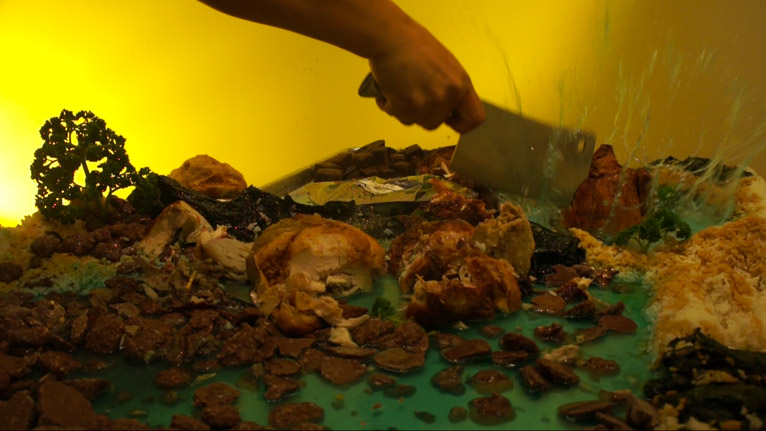SONG DONG: A BLOT ON THE LANDSCAPE
| December 1, 2010 | Post In LEAP 6

Song Dong’s latest outing at Pace Beijing consists of four video projections in a single dark room, sealed off by labyrinthine curtains. Each video features a seasonal diorama of a landscape, entirely composed of cooked and uncooked foods. As a composition of form and color, each of the foodscapes is aesthetically appealing in a peculiar, oddly comforting way. Perhaps, if unchanged as a composition, the landscapes could induce a meditative state of tranquility akin to one of the framed video-photos of perpetually flowing waterfalls hanging on the walls of psychiatrists’ offices. Within the context of a gallery space, the static images could have served as a commentary on the organic, self-sufficient and recycling nature of the world. Or, perhaps, if less in-tune with contemporary fetishes, as an alternative-media rendition of Giuseppe Arcimboldo.
But in negation to these more palatable alternatives, within a minute a symbol of ominous foreshadowing appears in each video, realized with various painfully awkward infringements upon the man-made harmony of the landscape. In A Blot on the Landscape—Chop Stroke, for example, a hand holding a cleaver appears on the screen and starts to cut up the landscape, revealing the mountains to be composed of roast chicken and the fields of brown rice. The methodical pace of the chopping is similar to Wang Qingsong’s 2009 video 123456 Chops. After the massacre, the plastic packaging for the store-bought chicken is revealed stashed behind the mountains. This blot is crucial to the intention of the work, reminiscent of microphones that are sometimes left accidentally hanging over the camera shot in film. The viewer’s attention is then drawn to the hand, which aggressively drips blood from an open cut onto the destroyed platter as a belated, sadistic garnish. The drops of blood and the efficiency of the chopping indubitably create an atmosphere of violence, but what gives the video its disturbing quality is the fact that the presence of the food is revealed in the same instance as the violence; it is revealed through the violence.
Not all the videos are so dire. A Blot on the Landscape—Rain and Rice Stroke offers a postcard picture in wintry white through the mashing of some unidentified starchy vegetable. The iron of the platter is conveniently evocative of an iced-over lake, which is bombarded with gargantuan grains of rice, in a ferocious winter storm. A small knife with a black handle drops onto the side of the platter, and awkwardly bounces off, disappearing to the side. A Blot on the Landscape—Wind and Water Stroke entails voluptuous raw slabs of sushi-grade salmon, a delectable gastronomic landscape until a vulgar bottle of gatorade enters the screen from the side, and by pouring a red liquid, creates a lake between the fleshy mountains of fish. Quite unexpectedly, a blow-dryer appears, and lovingly makes the scattered trees of parsley sway and the lake ruffle with small red waves. None of the videos have sound effects, but the sequence almost calls for restaurant jazz.
Where Song Dong’s early videos and performances worked within the gap between art and life, these pieces seem more concerned with sublimating everyday life into a kind of formalism. The intentional mistake in each of the works—the appearance of the packaging, the dropped knife—is meant to be the catalyst for artistic appreciation. And the revelation of ruse is made to make the art accessible to the viewer, and to make the viewer enter the art. While the videos do function effectively, playing to the intrinsic familiarity of food, the success of the “blot” is dubious. In a way, it reveals the limits of Song’s position more generally. Perhaps the very idea of presenting philosophical concepts in an ordinary way, we start to think, presumes a position of superiority present, if not so immediately evident, throughout his entire oeuvre. Darja Filippova

